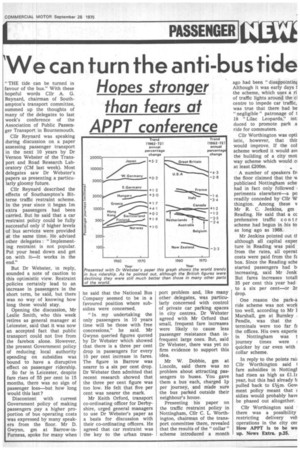We can turn the anti-bus tide
Page 21

If you've noticed an error in this article please click here to report it so we can fix it.
Hopes stronger than fears at
APPT conference "THE tide can be turned in favour of the bus." With these hopeful words ClIr A. G. Reynard, chairman of Southampton's transport committee, summed up the thoughts of many of the 'delegates to last week's conference of the Association of Public Passen ger Transport in Bournemouth. Cllr Reyna d was speaking during discussion on a paper assessing passenger transport in the next 10 years by Dr Vernon Webster of the Transport and Rod Research Laboratory (CM. last week). Most delegates saw Dr Webster's papers as presenting a particularly gloomy future.
ClIr Reynard described the effects of Southampton's Bitterne traffic restraint scheme. In the year since it began lm extra passe gers had been carried. But he said that a car restraint policy could be fully successful only if higher levels of bus services were provided at the same time. He advised other delegates : " Implementing restraint is not popular. Put your head down and get on with it—it works in the end."
But Dr Webster, in reply, sounded a nOte of caution to this optimistic view. Restraint policies certainly lead to an increase in Passengers in the i short term, 1e said, but there was no way of knowing how long these vkaild stay.
Opening the discussion, Mr Leslie Smith, who this week retires as general manager at Leicester, said that it was now an accepted' fact that public transport could not live from the farebox alone. However, the present C.rovernment policy of reducing local authority spending on subsidies was bound to liave a disruptive effect on passenger ridership.
So far in Leicester, despite fare rises of 55 per cent in 15 months, there was no sign of passenger 1 s—but how long would this la t?
Discontent with current Government policy of making passengers pay a higher proportion of bus operating costs was expressed by many speakers from the floor. Mr D. Gwynn, gm at Barrow-inFurness, spoke for many when he said that the National Bus Company seemed to be in a favoured position where subsidies were concerned.
"In my undertaking the only passengers in 10 years time will be those with free concessions," he said. Mr Gwynn queried figures quoted by Dr Webster which showed that there is a three per cent drop in passengers for every 10 per cent increase in fares. The figure in Barrow was nearer to a six per cent drop. Dr Webster then admitted that recent research showed that the three per cent figure was too low. He felt that five per cent was nearer the mark.
Mr Keith Orford, transport co-ordinating officer for Derbyshire, urged general managers to use Dr Webster's paper as a basis for discussion with their co-ordinating officers. He agreed that car restraint was the key to the urban trans port problem and, like many other delegates, was particularly concerned with control of private car parking spaces in city centres. Dr Webster agreed with Mr Orford that small, frequent fare increases were likely to cause less passenger resistance than infrequent large ones. But, said Dr Webster, there was yet no firm evidence to support this idea.
Mr W. Dobbie, gm at Lincoln, said there was no problem about attracting passengers to buses. You gave them a bus each, charged lp per journey, and made sure the bus parked outside their neighbour's house.
Presenting his paper on the traffic restraint policy in Nottingham, Cllr C. L. Worthington, chairman of the transport committee there, revealed that the results of the " collar " scheme introduced a month ago had been "disappointing Although it was early days f the scheme, which uses a ri of traffic lights around the ci centre to impede car traffic, was true that there had be " negligible " patronage of t 18 "Lilac Leopards," int: duced to promote park a ride for commuters.
CHI. Worthington was opti istic, however, that thir would improve. If the col scheme worked it would av( the building of a city mot way scheme which would ci at least £200m.
A number of speakers fri the floor claimed that the v, publicised Nottingham sche had in fact only followed periments elsewhere—a po readily conceded by ClIr W thington. Among these v Mr R. C. Jenkins, gm Reading. He said that a cc prehensive traffic con t r scheme had begun in his to as long ago as 1968.
Mr Jenkins pointed out ti although all capital exper ture in Reading was paid from the rates, all operat costs were paid from the ft box. Since the Reading sche started passengers had bt increasing, said Mr Jenk But fares increases total' 35 per cent this year had to a six per cent—or 2r drop.
One reason the park-a ride scheme was not work too well, according to Mr I Marshall, gm at Burnley . Pendle, was that the terminals were too far ft the offices. His own experie in Nottingham was t Journey times were quicker by car even with collar scheme.
In reply to the points rai: Cllr Worthington said fare subsidies in Nottingl had risen as high as Mr year, but this had already b pulled back to 0/2m. Gov4 ment policy meant that sidies would probably havt be phased out altogether.
Cllr Worthington said there was a possibility restricting delivery veh operations in the city cer How APPT is to be wo up. News Extra. p.25.




































































































